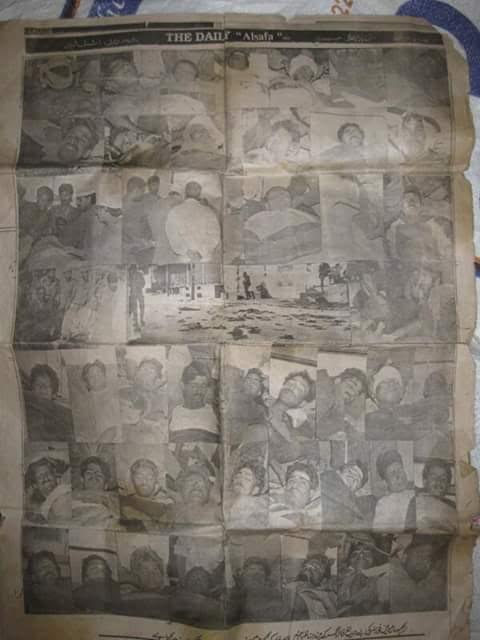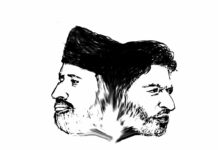
The 1993 massacre by Border Security Forces in south Kashmir’s Bijbehara town where more than 35 civilians were killed and unknown number injured is a symbol of India’s repressive rule in Kashmir. Almost two decades have passed but the perpetrators of one of the worst atrocities committed on the people of Kashmir continue to roam free while the state basks in a delusional cycle of hysteria and make-believe that a new peace has dawned in Kashmir in which we will progress and prosper!
Bijbehara was our Peterloo. It was our Zilan, our Jallianwala Bagh. A brief background will help the impressionable readers. Kashmir had erupted against Indian rule. The forces that New Delhi brought to control the dissent knew the dangers of operating in unknown terrains. Not a day passed when the ordinary people didn’t die. This was a time when Kashmir was one of the most dangerous places on the globe. A gradual rise in violence took the tool on the troops, thus an example had to be set. Bijbehera was chosen because the forces had suffered large casualties there. To avenge their operational failure, they decided to target the ordinary people. The massacre was carefully planned. People of Bijbehara were told that they would soon forget to laugh.
On the fateful day, there was chaos, hatred for natives and a lust for blood among the security forces. Around 10,000 to 15,000 people had gathered to protest the army siege of Hazratbal mosque. A procession marched through the village demanding the siege be lifted. As they reached Gooriwan locality in Bijbehara, all hell broke loose. The forces of BSF’s 74 Batallion didn’t discriminate as they fired gunshots at the protestors; harmless children, women and men.
People say those who were injured and lay writhing in pain on a bloodied ground were shot again to ensure that they were dead. And those who took injured to nearby hospitals were chased and shot there. Even the barbarians would be put to shame by the sheer scale of atrocity carried out that day. The people of Kashmir responded. The valley reverberated with cries of “We want freedom!” A dark, seminal chapter in a long era of repression was written. The coercion had begun before Bijbehara. The massacre was prelude to what lay in store for the people who were not willing to cow down before the forces of brutality.

Bijbehara has become history now. And that history repeats itself every other day in Kashmir. That day, it was Muhammad Shafi Wagay who was chased and shot dead when he took the blood-soaked body of his brother to a hospital for treatment in Bijbehara. Today, it is Wamiq Farooq. The supposed guardians of resistance movement, who don’t waste a moment to issue shutdown calls over every other petty issue, have conveniently forgotten Bijbehara. Not even a statement of condemnation is issued. Silence is an indication of complicity and lost morality.
Bijbehara is a reflection of what occupation of land does to its people. It must serves as an example of ineffectiveness of coercion. I am tempted to quote Hilary Mantel. “It is necessary to understand that the dead are real, and have power over the living. It is helpful to have encountered the dead firsthand, in the form of ghosts.” The ghosts of Bijbehera remind us that we are a dead people!
(The views expressed are personal.)
















Jehangir, I do not completely understand and I do not support the point you’re trying to make here.
By all means the massacre of Bij Behara is condemnable and it demands the greatest possible criticism in all respects. In my opinion, bullets are never an answer to any question howsoever serious it is.
However, as a journalist I will like to see a bit more restraint from you lest this article might reignite the hidden anger amongst our fellow Kashmiris. Of course, the peace we see right now in Kashmir is “managed” peace and you correctly mention that the inability of India (or for that matter Pakistan) to solve the Kashmir crisis goes to show the “ineffectiveness of coercion” in solving this crisis.
I will like to add that in the same direct tone that firebrand journalism isn’t a solution either. I wish everyone understands it. We must all try to instil the feeling of brotherhood, peace, compassion and tolerance inside us. Whatever the solution to Kashmir, it must and it will surely come through peace and dialogue.
We must all remember the Bij Behara massacre as an unfortunate event which deserves strongest condemnation but as citizens try to ensure that conditions leading to it are never happen again. And in the same manner BSF should severely punish those responsible and learn from it to ensure that similar incident do not happen again. Help and understanding is needed from all quarters.
An article of such tone about such an unfortunate incident in a leading Kashmir website by a Kashmiri journalist of your stature is totally uncalled for. It will not do anyone any good.